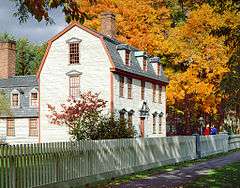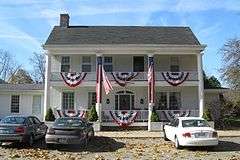Historic Deerfield
|
Old Deerfield Historic District | |
|
Wells-Thorn House | |
  | |
| Location | Deerfield, Massachusetts |
|---|---|
| Built | 1650 |
| Architect | Benjamin,Asher; et al. |
| Architectural style | Greek Revival, Federal |
| NRHP Reference # | 66000774[1] |
| Significant dates | |
| Added to NRHP | October 15, 1966 |
| Designated NHLD | October 9, 1960, see |




Historic Deerfield is a museum dedicated to the heritage and preservation of Deerfield, Massachusetts, and history of the Connecticut River Valley. Its historic houses, museums, and programs provide visitors with an understanding of New England's historic villages and countryside. It is located in the village of Old Deerfield which has been designated a National Historic Landmark District (as the Old Deerfield Historic District), and is listed on the National Register of Historic Places. The museum also hosts the Dublin Seminar for New England Folklife.
Sites
Eleven historic house museums are located in Historic Deerfield. Most are viewed on guided tours. A modern museum and a visitors center are part of the complex. The museum offers special exhibitions, family activities, workshops and seminars on historic subjects, and a gift shop. The Deerfield Inn is available for visitors.
- Ashley House is the 1734 home of Deerfield's 18th-century minister, with furnishings of the Connecticut River elite and English ceramics.
- Allen House is a 1734 home that was the 20th-century residence of Historic Deerfield's founders, Henry and Helen Flynt. The Flynt family renovated the house in 1945. The home features their personal collection of American antiques and is open by arrangement.
- Stebbins House is the 1799 home of Asa Stebbins. The brick house features Federal period decorations, including neoclassical furnishings dating from 1790 to 1830.[2] Highlights include French scenic wallpaper panels manufactured by Joseph Dufour et Cie that depict the voyages of Captain Cook. This house is open for self-guided tours.
- Barnard Tavern is a 1795 tavern currently closed for restoration and reinterpretation. It is scheduled to reopen in fall 2013.
- Dwight House is a c. 1754 house built in Springfield, Massachusetts. It was moved to Deerfield in 1950 when it was threatened with demolition. The house reopened in 2009 as a museum of historic trades.
- Frary House is a c. 1750 home interpreted to depict the 1890s home of Miss C. Alice Baker, who restored the house in 1892. Displays include New England antiques, Arts and Crafts needlework, ironware, and basketry. The house features Miss Baker's role in fostering the Colonial Revival in Deerfield.
- Sheldon House was built in 1754-5 and is interpreted to the period of 1780 to 1810. This house is open for self-guided tours.
- Wells-Thorn House is a 1747 house featuring rooms demonstrating different periods and lifestyles from 1725 to the 1850s.
- Williams House is a c. 1730 house extensively renovated in 1817. The house features Federal-style furnishings and decorations.
- Flynt Center of Early New England Life is a modern museum with changing exhibits of history, heritage crafts, decorative arts, and other topics.
- Hall Tavern Visitor Center was originally built c. 1785 in Charlemont, Massachusetts; a ballroom wing was added around 1815. The building was moved to Deerfield and converted to a visitors center.
Local geography
Historic Deerfield is based on a 330-year-old, mile-long street situated along the Connecticut River in the Pioneer Valley of Western Massachusetts.
Deerfield history
At the time of European contact, the area now known as Deerfield was inhabited by the indigenous Pocumtuck nation. The town was originally established as a grant of land to the residents of Dedham, Massachusetts, who had given land to the Massachusetts Bay Colony for the purpose of settling Christianized Indians.
For much of the colonial period Deerfield was one of New England's frontier villages. Briefly abandoned during King Philip's War in the 1670s, it was subjected to French and Indian raids during King William's War in the 1690s. In Queen Anne's War the village was subjected to a major raid, in which 40 percent of the population was taken prisoner. French and allied Abenaki, Mohawk, and other warriors breached the palisade and raided the village. They killed numerous settlers and took more than 100 residents captive. Before leaving for Canada, the raiding party burned the village.
Almost all of those who survived the attack and the march to Canada eventually were ransomed and returned to New England. Eunice Williams, captured at age eight, was adopted by a Mohawk family and became totally assimilated. She married a Mohawk man and had a family with him, choosing not to return to New England. In 1741 she visited surviving siblings for the first time, and she made two more visits later.
Deerfield survived the raid, and the frontier was pushed farther north and west. Settlers eventually moved into present-day Vermont and established settlements farther up the Connecticut River in New Hampshire.
Collection database
Historic Deerfield's collections can be searched on the database maintained by the Five College Museums/Historic Deerfield.[3]
See also
| Wikimedia Commons has media related to Historic Deerfield. |
- Borden Base Line
- National Register of Historic Places listings in Franklin County, Massachusetts
- List of National Historic Landmarks in Massachusetts
References
- ↑ National Park Service (2008-04-15). "National Register Information System". National Register of Historic Places. National Park Service.
- ↑ Historic-deerfield.org
- ↑ Museums.fivecolleges.edu
External links
- Historic Deerfield
- Town of Deerfield
- Old Deerfield Historic District - National Historic Landmarks Program
Coordinates: 42°32′49.2″N 72°36′14.9″W / 42.547000°N 72.604139°W
.jpg)